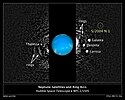Hippokamp (księżyc)
 Lokacja w stosunku do Neptuna i innych księżyców | |
| Planeta | |
|---|---|
| Odkrywca | Mark Showalter, I. de Pater, J.J. Lissauer, R.S. French[1] |
| Data odkrycia | 1 lipca 2013 |
| Tymczasowe oznaczenie | S/2004 N 1 |
| Charakterystyka orbity | |
| Półoś wielka | 105 280 km[2] |
| Okres obiegu | ok. 0,9362 d[2] |
| Własności fizyczne | |
| Średnica równikowa | ok. 34 km[3] |
| Jasność obserwowana (z Ziemi) | ok. 26,5m |
Hippokamp (S/2004 N 1, Neptun XIV) – najmniejszy znany księżyc Neptuna. Został odkryty przez Marka Showaltera i jego współpracowników[1] 1 lipca 2013 roku na podstawie analizy archiwalnych zdjęć wykonanych za pomocą Kosmicznego Teleskopu Hubble’a w latach 2004–2009[4].
Hippokamp krąży wokół Neptuna w odległości ok. 105 tys. km. Jedno okrążenie zajmuje mu ok. 22,5 godziny[2][4].
Księżyc ten jest prawdopodobnie fragmentem większego księżyca Proteusza, który został oderwany wskutek zderzenia z kometą lub innym obiektem miliardy lat temu[3].
Nazwa księżyca pochodzi od stworzeń z mitologii greckiej i rzymskiej – hippokampy to pół-konie, pół-ryby, które ciągnęły rydwan Neptuna[3].
Zobacz też
- Chronologiczny wykaz odkryć planet, planet karłowatych i ich księżyców w Układzie Słonecznym
- Księżyce Neptuna – zestawienie podstawowych danych
Przypisy
- ↑ a b Planetary Satellite Discovery Circumstances (ang.). [dostęp 2013-07-16].
- ↑ a b c Kelly Beatty: Neptune's Newest Moon (ang.). Sky & Telescope, 15 lipca 2013. [dostęp 2013-07-15]. [zarchiwizowane z tego adresu (2013-07-16)].
- ↑ a b c Astronomowie wyjaśnili pochodzenie najmniejszego księżyca Neptuna. W: Dziennik Naukowy [on-line]. 2019-02-21. [dostęp 2019-02-26].
- ↑ a b Hubble Finds New Neptune Moon (ang.). W: HubbleSite [on-line]. Space Telescope Science Institute, 2013-07-15. [dostęp 2015-01-13].
Linki zewnętrzne
- S/2004 N1 (ang.). W: Solar System Exploration [on-line]. NASA. [dostęp 2018-12-23].
Media użyte na tej stronie
This is a revised version of Solar_System_XXIX.png.
This composite Hubble Space Telescope picture shows the location of a newly discovered moon, designated S/2004 N 1, orbiting the giant planet Neptune. The moon is so small (no more than 12 miles across) and dim, it was missed by NASA's Voyager 2 spacecraft cameras when the probe flew by Neptune in 1989. Several other moons that were discovered by Voyager appear in this 2009 image, along with a circumplanetary structure known as ring arcs.
Mark Showalter of the SETI Institute discovered S/2004 N 1 in July 2013. He analyzed over 150 archival Neptune photographs taken by Hubble from 2004 to 2009. The same white dot appeared over and over again. He then plotted a circular orbit for the moon, which completes one revolution around Neptune every 23 hours. The black-and-white image was taken in 2009 with Hubble's Wide Field Camera 3 in visible light. Hubble took the color inset of Neptune on August 19, 2009.
Uploader's notes: The original NASA/Cowart PNG image has been modified by flattening (combining layers), cropping and converting to JPEG format.
Original caption released with image:
Voyager 2 Narrow Angle Camera image of Neptune taken on August 20, 1989 as the spacecraft approached the planet for a flyby on August 25. The Great Dark Spot, flanked by cirrus clouds, is at center. A smaller dark storm, Dark Spot Jr., is rotating into view at bottom left. Additionally, a patch of white cirrus clouds to its north, named "Scooter" for its rapid motion relative to other features, is visible.
This image was constructed using orange, green and synthetic violet (50/50 blend of green filter and UV filter images) taken between 626 and 643 UT.
Image Credit: NASA / JPL / Voyager-ISS / Justin Cowart


